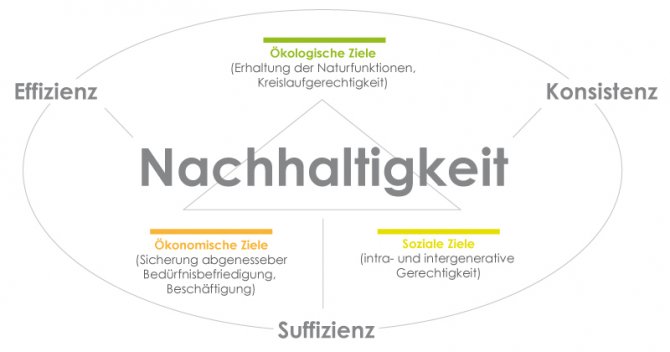The principle of sustainability
A society can be designated as sustainable, when this society itself remains able to exist. (…) so foresighted that it does not undermine its own material and social fundamentals of existence. (Mario Guenter)
Sustainability means the organization of a system in a way that it can endure in the long run. The most widely spread definition of sustainability was formulated by the so-called Brundtland Commission in 1987: Sustainable development is a “development, which meets the needs of current generations without compromising the ability of future generations to meet their own needs” and to choose their own life styles. (Brundtland report, 1987)
The UN Commission emphasizes through this definition intra- and intergenerational justice, which is the basis of the sustainability concept: On the one hand distribution between current generations as a balance between people, mainly related to distribution between the Global North and the Global South. On the other, the balance between current and future generations, i.e. the duty to stand for conservation of the environment and stability of society in favor of the children and grandchildren.
The history of sustainability
Already in the dawn of the 18th century, the idea of sustainability was for the first time formulated for forestry. In 1713, Hans Carl von Carlowitz wrote about the “sustainable use” of forests, of which in the long run no more is felled than can regrow.
This concept, however, only received broader popularity and political attention at the beginning of the environmental movement in the 1970ies, as a result of which ministries of the environment have been established in Europe (for instance, since 1971 in Austria), and large environmental NGOs have been founded (for instance Global 2000 in August 1982). In 1972, the first World Conference on the Human Environment took place in Stockholm, in 1992 the very successful UN Conference on Environment and Development took place in Rio de Janeiro.
In Europe, the European Sustainable Development Strategy was resolved in Goeteborg in 2001, and revised in 2006. Austria has its own Strategy for Sustainable Development since 2002.
The three dimensions of sustainability
Sustainability appears on three levels: in the ecological dimension (environment), in the economic dimension (economy), and in the social dimension (society). Frequently sustainability is depicted by means of a three pillar model. This model suggests, however, that the pillars were closed spheres, which generally is not the case in reality. The “sustainability triangle” solves this problem, because it becomes clear that the dimensions of sustainability are connected to one another. In the scientific discourse, partly a fourth dimension of sustainability is addressed, which is partly designated as “culture”, partly as an institutional dimension, in the sense of governance and political management system.
Sustainability as a principle of justice
The normative concept of sustainability centers on the question of justice. Without a term of justice, the idea of sustainability loses its meaning, because it is determined according to just distribution between current and future generations, and thus also according to just behavior towards one’s neighbors, future generations and nature itself. Sustainability is based on the ethical postulate that all people, independent of their place of birth (intra-generational) and their date of birth (inter-generational) have the right to a good life.
Through focusing on the ecological dimension, the demand for just distribution as basic principle of sustainability moves into the background.

